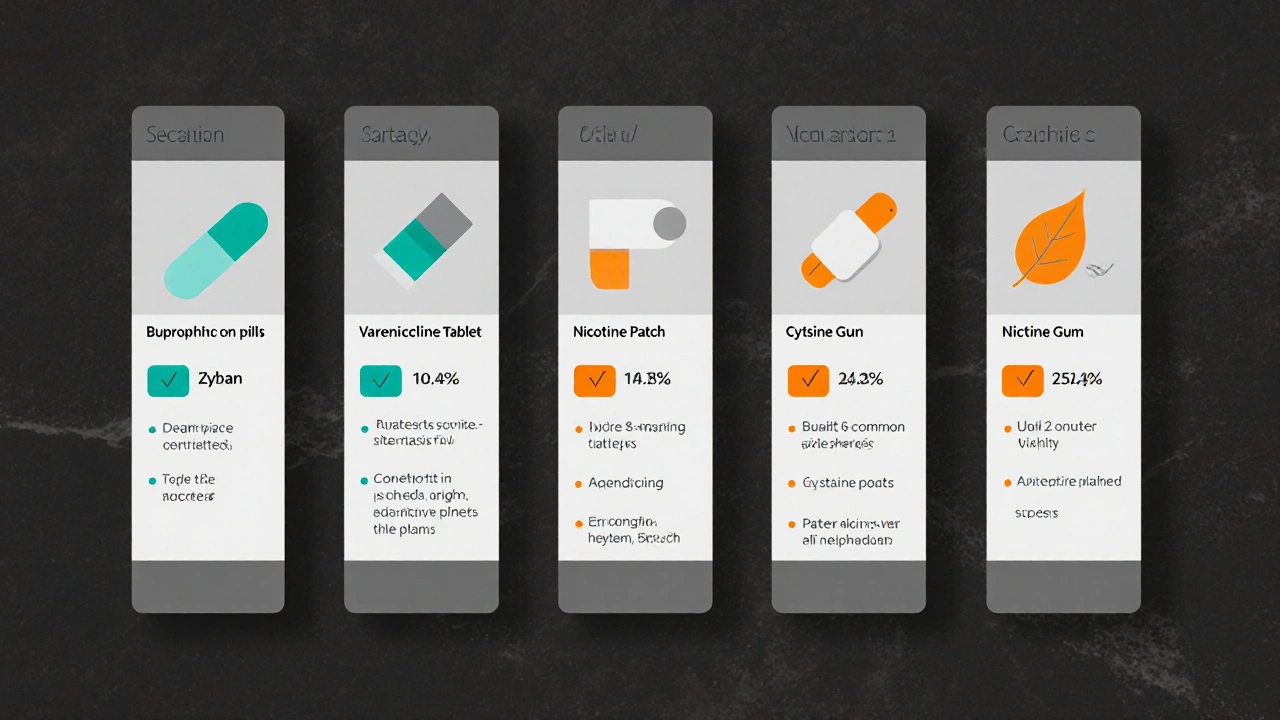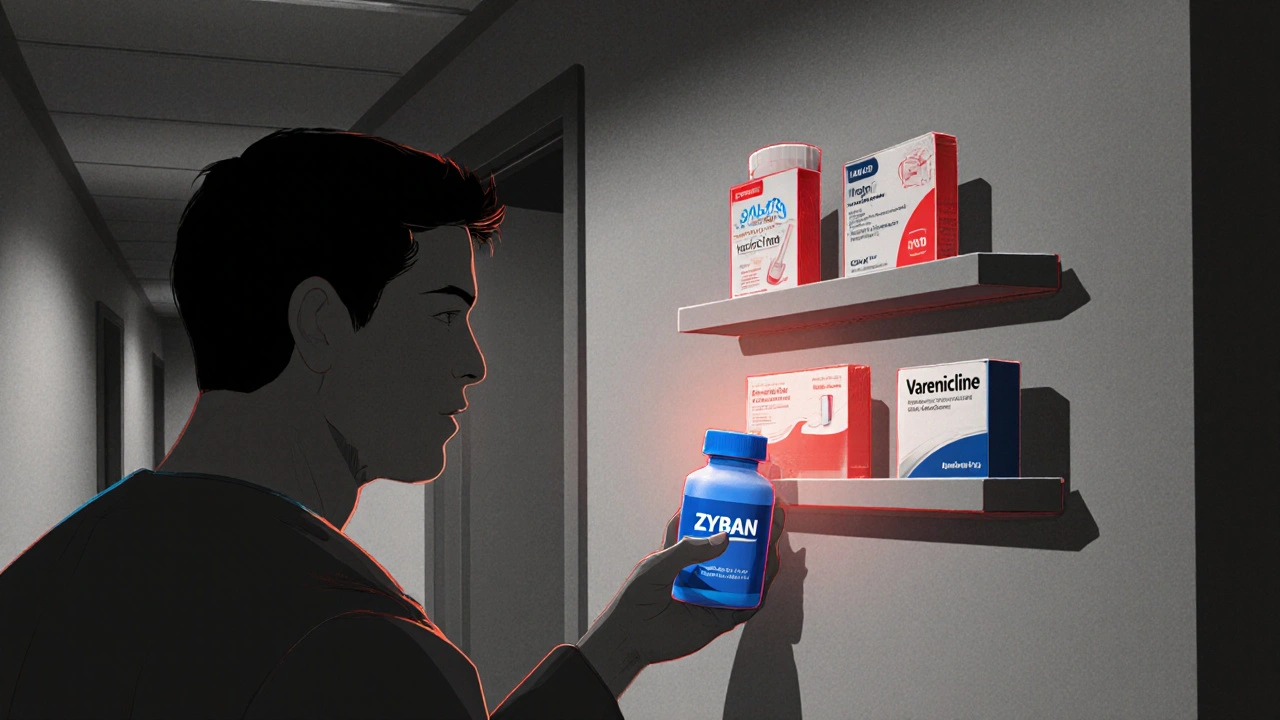Smoking Cessation Aid Selector
Find Your Best Quit-Smoking Aid
Answer a few questions to discover which smoking cessation option works best for you
What's most important to you?
What health conditions do you have?
How much are you willing to spend?
Preferred method of use
Recommended Options
Key advantages:
Considerations:
Other options to consider:
Trying to quit smoking can feel like a battlefield, and the right weapon makes all the difference. Zyban is a prescription medication that contains bupropion, an antidepressant repurposed to curb nicotine cravings and withdrawal symptoms. While Zyban works for many, a slew of other options exist, from other pills to patches and even chewable gum. This guide lines up Zyban side‑by‑side with the most common alternatives, so you can see which fits your lifestyle, budget, and health profile.
Why a Comparison Matters
Not every quit‑smoking aid works the same way. Some target brain receptors directly, others flood the body with low‑dose nicotine to wean you off. Your choice should consider efficacy, side‑effect profile, cost, and how you prefer to take the medication. Below we break down the key decision criteria that most people weigh when they ask, “Is Zyban right for me, or should I try something else?”
Decision Criteria Checklist
- Mechanism of action: Does the drug affect dopamine, nicotine receptors, or both?
- Effectiveness: Success rates in clinical trials and real‑world use.
- Side‑effects: Common and serious adverse events.
- Dosage & administration: Pills, patches, gum, or inhaler.
- Cost & insurance coverage: Out‑of‑pocket expenses in Australia and overseas.
- Contra‑indications: Interactions with other meds or health conditions.
Head‑to‑Head Comparison Table
| Feature | Zyban (Bupropion) | Varenicline (Chantix) | Nicotine Patch (NRT) | Nicotine Gum (NRT) | Cytisine (Tabex) |
|---|---|---|---|---|---|
| Mechanism | Increases dopamine & norepinephrine, reducing cravings | Partial agonist at α4β2 nicotinic receptors | Delivers steady low‑dose nicotine through skin | Delivers nicotine via oral mucosa | Partial agonist at nicotinic receptors (plant‑derived) |
| Typical Success Rate (12‑month abstinence) |
~30% (vs 20% placebo) | ~45% (vs 18% placebo) | ~25% (vs 15% placebo) | ~20% (vs 10% placebo) | ~35% (limited data, European studies) |
| Common Side‑effects | Insomnia, dry mouth, headache | Nausea, vivid dreams, mood swings | Skin irritation, sleep disturbances | Jaw soreness, throat irritation | Gastro‑intestinal upset, mild dizziness |
| Serious Risks | Seizure risk (dose‑related), rare psychiatric events | Possible cardiovascular events, rare neuropsychiatric issues | Rare allergic reaction | Rare nicotine toxicity if overused | Limited data, generally mild |
| Dosage Form | Oral tablet, 150mg twice daily (start) | Oral tablet, titrated up to 1mg twice daily | Transdermal patch, 21mg → 14mg → 7mg | Chewing gum, 2mg or 4mg | Oral tablet, 1.5mg three times daily |
| Average Cost (AU$) for 12‑week course | ≈$150-$200 (generic) | ≈$250-$300 (brand) | ≈$80-$120 | ≈$70-$110 | ≈$60-$90 (imported) |
| Prescription Required in Australia | Yes | Yes | No (over‑the‑counter) | No (over‑the‑counter) | Not approved; often imported |

Deep Dive into Each Option
1. Zyban (Bupropion)
Bupropion was first approved as an antidepressant in the early 2000s, then repurposed for smoking cessation after trials showed a 10‑percentage‑point boost in quitting rates. The typical regimen starts with 150mg once daily for three days, then ramps to 150mg twice daily for a 7‑week course, followed by a 1‑week taper. Because it works on dopamine pathways, it can help with the emotional side of cravings, not just the physical nicotine dependence.
Key pros include oral dosing (no patches or gum), no nicotine exposure, and modest cost when generic versions are used. However, you must avoid high‑dose bupropion if you have a history of seizures, bulimia, or are on certain antipsychotics. The drug also interferes with some migraine medications, so a full health check with your GP is essential.
2. Varenicline (Chantix)
Varenicline is a partial agonist at the α4β2 nicotinic acetylcholine receptor. By binding to the same spot nicotine does, it blunts the “rush” while still providing a mild nicotine‑like signal that eases withdrawal. The standard schedule is 0.5mg once daily for three days, then 0.5mg twice daily for four days, and finally 1mg twice daily for 11 weeks.
Its biggest selling point is the highest success rate among prescription options. On the flip side, nausea is common, and early reports of mood changes sparked warnings in the U.S., though Australian regulators deem it safe for most adults without severe psychiatric history.
3. Nicotine Replacement Therapy (Patch)
The Nicotine Patch delivers a constant low dose of nicotine through the skin. You start with a 21mg patch for six weeks, then step down to 14mg and finally 7mg, each for two‑week intervals. Because the nicotine level stays steady, cravings tend to be milder, and you avoid the hand‑to‑mouth habit of smoking.
Patch users love the simplicity-just one piece of adhesive a day. Problems arise if you have skin sensitivity or if the patch interferes with sleep when placed too close to the head.
4. Nicotine Gum
Nicotine Gum comes in 2mg and 4mg strengths. You chew slowly until you feel a tingling, then park the gum between your cheek and gum to allow nicotine absorption. The typical regimen calls for 1-2 pieces every 1-2hours during the first six weeks, then tapering to “as needed.”
Gum works well for people who miss the oral fixation of smoking. It can, however, cause jaw soreness or throat irritation if over‑chewed.
5. Cytisine (Tabex)
Cytisine is a plant‑derived alkaloid used in Eastern Europe for decades. Like varenicline, it’s a partial nicotinic receptor agonist, but it’s cheaper and technically not approved by the Australian Therapeutic Goods Administration (TGA). Some Australians import it under personal‑use exemptions.
Clinical data from a 2023 European trial showed a 35% quit rate after 12 weeks, comparable to Zyban and markedly better than placebo. Side‑effects are mostly mild gastrointestinal upset. Because it’s not formally regulated, quality can vary, so sourcing from reputable suppliers is crucial.
How to Choose the Right Aid for You
Think of the decision as a match‑making exercise. Ask yourself these questions:
- Do I prefer a pill or a nicotine‑based product?
- Is my doctor comfortable prescribing a medication that affects brain chemistry?
- Do I have any health conditions-like a seizure disorder or severe anxiety-that rule out certain drugs?
- How much am I willing to spend out‑of‑pocket?
- Do I need something that also tackles the behavioral habit (chewing, patch adherence)?
When you line up your answers, patterns emerge. For example, if you have a history of migraines, you might skip varenicline. If you hate swallowing pills, a nicotine patch or gum could be a better fit. If cost is the main barrier, generic bupropion (Zyban) or cytisine may give the best bang for your buck.
Potential Pitfalls and How to Avoid Them
- Missing the titration phase: Jumping straight to the full dose of bupropion or varenicline can raise side‑effect risk. Always follow the gradual increase schedule.
- Combining nicotine products: Using a patch while chewing gum can lead to nicotine overdose-watch for symptoms like rapid heartbeat or nausea.
- Skipping counseling: Medication works better when paired with behavioral support. Many Australian quit‑lines offer free phone counseling.
- Ignoring drug interactions: Bupropion raises the level of certain antidepressants; varenicline can interfere with nicotine‑containing birth control patches. A pharmacist review saves headaches later.

Quick Reference Cheat Sheet
- Zyban (Bupropion): Oral pill, no nicotine, moderate efficacy, seizure warning.
- Varenicline (Chantix): Oral pill, highest efficacy, nausea common, mood‑related cautions.
- Nicotine Patch: Skin‑applied, steady nicotine, easy once‑daily, skin irritation possible.
- Nicotine Gum: Chewable, tackles oral habit, jaw soreness risk.
- Cytisine (Tabex): Plant‑based pill, affordable, not TGA‑approved, mild GI side‑effects.
Bottom Line: Why Zyban vs alternatives is a decision you can own
If you value a non‑nicotine option, have a stable routine for taking pills, and want a cost‑effective solution, Zyban often wins the practicality vote. If you crave the highest quit rates and can tolerate a few days of nausea, varenicline may be worth the trade‑off. For those who dislike pills altogether, the patch or gum stay in the game. And if you’re hunting a bargain, cytisine offers a promising, albeit off‑label, path.
Whatever you pick, pair it with counseling, stay honest about side‑effects, and give yourself at least 12 weeks to gauge success. Quitting isn’t a sprint; it’s a marathon where the right support can turn a stumble into a finish line.
Frequently Asked Questions
Can I use Zyban and nicotine patches together?
It’s generally not recommended because you’d be combining a non‑nicotine medication with additional nicotine, which can increase the risk of side‑effects like insomnia or elevated blood pressure. If you’re already on a patch, talk to your doctor before starting Zyban.
How long does Zyban stay in my system?
Bupropion has a half‑life of about 21 hours, so it takes roughly 4-5 days to clear most of the drug after you stop taking it. However, the brain‑chemical changes it triggers can linger longer.
Is Cytisine legal to buy in Australia?
Cytisine is not approved by the TGA, so you can’t purchase it from Australian pharmacies. Some users import it for personal use, but you should verify the source and discuss it with a healthcare professional.
What should I do if I experience a seizure while on Zyban?
Seek emergency medical care immediately. Afterward, your doctor will likely stop bupropion and evaluate other quit‑smoking options.
Do I need a prescription for nicotine gum?
No, nicotine gum is sold over‑the‑counter in pharmacies and supermarkets. You can buy a 2mg or 4mg pack without a doctor’s note.


Choosing the right quit‑smoking aid can feel overwhelming, but breaking it down into what matters most to you helps a lot. Think about how you like to take medication-whether a daily pill fits your routine or you prefer something you can apply or chew. Also weigh any health conditions you have; for example, seizure history makes bupropion a poor choice. Cost is another realistic factor; generic bupropion often ends up cheaper than brand‑name options. Ultimately, matching the method to your lifestyle gives you the best chance of staying smoke‑free.